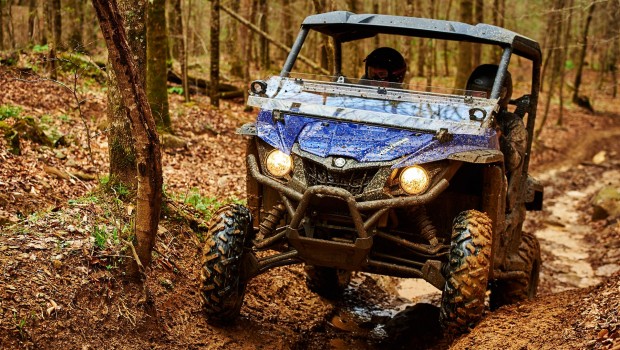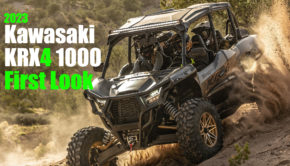2016 Yamaha Wolverine R-Spec First Test
As the company that first created the recreational side-by-side, Yamaha is working hard to regain leadership status in the segment. On a mission to release five new models over 3 years, Yamaha has released their third model, the 2016 Wolverine R-Spec with the Viking and Viking 6 designed for work first and recreation second. The Wolverine takes direct aim at trail riders, explorers, and hunters.
Not a long wheelbase whoop pounder like the 1000cc machines of the high-performance sport segment, the Wolverine is designed to be very off-road capable, but in a different way. Its shorter wheelbase, innovative chassis, high-performance suspension, and modest engine size are more focused on exceling on technical trails where tractability and nimbleness shine.
To put the machine to the test, Yamaha invited us to Brimstone located in Huntsville, Tennessee. Sampling a small portion of Brimstone’s 20,000 acres, Yamaha laid out a course that was full of rutted climbs, technical rocky sections, tight twists through the trees, with some intermediate-paced and a few high-speed trails thrown in.
Engine
The Wolverine is powered by a 708cc, four-valve, DOHC-equipped, liquid-cooled, four-stroke engine. It has a 103x85mm bore and stroke, and a 10.1:1 compression ratio. A Yamaha fuel-injection system delivers air and fuel to the engine via a 44mm throttle body.
The engine is mated to a Yamaha Ultramatic transmission, which engages using a centrifugal clutch. The clutch is said to eliminate drive belt slippage, improving belt life. The transmission features low and high forward ranges, plus neutral and reverse. There is no park in the transmission. Instead, there is a sealed rear parking brake, which delivers a good amount of power and warns you if you leave it engaged with a loud beeping sound. Engine braking comes standard in the transmission, which is capable of delivering engine braking to all four wheels, when four-wheel-drive is engaged. The drive system features selectable two-wheel-drive, four-wheel-drive, and four-wheel-drive with differential lock, controlled by a knob on the dash.

Power delivery is very linear, pulling well from bottom to top with the bulk of the power focused in the center of the RPM range.
The first thing we noticed is that the engine isn’t overly loud, from either outside or inside the car, allowing you to easily hold a conversation. Power delivery is very linear, pulling well from bottom to top with the bulk of the power focused in the center of the RPM range. Good torque and its centrifugal clutch-equipped transmission allowed us to crawl through low-speed rocky sections in high range with no hint of belt slippage. Its smooth delivery and adequate, but not overpowering, engine let you dial in just the right amount of power for the obstacle you’re trying to conquer.
As the trail opens up a bit, the engine feels fun and responsive, revving well for a single cylinder. With just a little mud, gravel, or loose dirt, the engine provides enough thrust to allow you to steer with the rear end. There was plenty of speed in reserve for fast, wide-open trails as we never reached its top speed, although the engine loses some of its snappy feeling at higher speeds.
Switching between two and four-wheel-drive was a quick and simple function, while stopped or cruising along. The Kawasaki Teryx limits the engine’s RPMs while diff lock is engaged; not so on the Wolverine. Having the ability to lock the front differential and have full throttle delivered to all four wheels definitely came in handy on a few occasions. We loved the confidence and performance it delivers, but found the front differential’s engagement and disengagement to take a little longer than expected. It sometimes required us to spend 10 or 15 seconds varying our speed and steering direction to allow the front differential’s gears to slide apart and disengage.
On long downhills or coasting into turns, the engine braking was smooth and very effective.
Suspension and Handling

The steel frame features plates, which are welded to the bottom for improved durability. The frame’s underside is upswept two inches on the sides improving ground clearance over obstacles that the tires are traversing, while reducing the chassis’ center contact patch.
The Wolverine R-Spec features an all-new chassis and suspension system. The steel frame features plates, which are welded to the bottom for improved durability. The frame’s underside is upswept two inches on the sides improving ground clearance over obstacles that the tires are traversing, while reducing the chassis’ center contact patch, making it easier to slide over obstacles that push its 11.4 inches of ground clearance to the limit. Innovative rear wheel protectors protrude from the lower frame rails letting the machine glide around trees and stumps without snagging a rear tire–– brilliant!

Innovative rear wheel protectors protrude from the lower frame rails letting the machine glide around trees and stumps without snagging a rear tire–– brilliant!
The frames a-arm mounting points are spaced closely together, allowing for more suspension travel and less bump steer. Wide arch lower a-arms that turn down on the ends help maximize ground clearance across a wider area. Yamaha equipped the R-Spec with long travel, KYB shocks featuring preload, high and low-speed compression, and rebound adjustment, giving you the ability to truly customize the ride of your machine. Suspension travel numbers are class leading measuring in at 9.7 inches up front and 10.6 inches out back.
The EPS model we tested features electronic power steering. Instead of using off the shelf tires, Yamaha worked with Maxxis to develop a version of its Bighorn 2.0 tires, with optimized performance specifically for the Wolverine. The 26×8-12 front and 26×10-12 rear tires come mounted on black steel wheels.
The Wolverine measures in at 60.5 inches wide, with a wheelbase of 81.3 inches, an overall length of 116.9 inches, and stands 74.2 inches in height. Fully laden with fluids, it weighs in at 1,311 pounds.

Handling on the Wolverine is confidence inspiring. Its steering accuracy, stability, and sufficient power allow you to fly down twisty trails.
Handling on the Wolverine is confidence inspiring. Directional control seemed quite good, only pushing on us once while attacking one particularly slick muddy corner. Its stability through turns and on side hills is outstanding. The Wolverine corners flat with little hint of body roll. Its steering accuracy, stability, and sufficient power allow you to fly down twisty trails.
On tight, technical rocky sections, the Wolverine ruled. Its power steering kept steering light, reducing feedback, while leaving you feeling connected to the trail. It was especially helpful with the front differential locked. While we did test the limits of the Wolverine’s ground clearance on a few occasions, the machine easily slid over anything that came in contact with the armored underside of the chassis.
Suspension performance is very good right out of the box with no adjustment. Perhaps we could have made it better with time to test; however, there were no glaring issues. High-speed impacts from rocks, roots, and potholes are well dampened. The shocks feature a couple inches of sag, which helps keep all four wheels in contact with the ground and driving traversing rock gardens. The trails at Brimstone were littered with water breaks, a few of which were shaped well enough that we couldn’t help but treat them as small jumps. We managed to find the limits of the suspension on a couple of occasions, but they never bottomed harshly. Good plushness, the ability to make full use of the travel, and good bottoming resistance are all byproducts of using well setup, long travel, high-performance shocks.
Brakes
The Wolverine is stopped by hydraulic disc brakes located at all four corners. Each wheel features its own 207mm rotor and dual piston caliper. We found the brakes to offer excellent feel and all the stopping power we could ask for. There’s plenty of power for long descents and it’s virtually impossible to overshoot a turn.
Cockpit Comfort

Yamaha outfitted the Wolverine with high-backed seats, with bolstered sides on the back. We found them to offer decent comfort. Yamaha worked to move the seats inboard of the tires, reducing motion transferred to the occupants.
Inside the cockpit, Yamaha outfitted the Wolverine with high-backed seats, with bolstered sides on the back. We found them to offer decent comfort. Yamaha worked to move the seats inboard of the tires, reducing motion transferred to the occupants. We found this tactic effective, without making us feel cramped. The bolt-in seats are adjustable, but not on the fly. The steering wheel doesn’t feature adjustable tilt. We found its placement comfortable, but that doesn’t mean everyone will feel the same. The seat belts are comfortable and don’t dig into your shoulder traversing bumps.

Doors come standard and feature latches, which close securely consistently. Unfortunately, the sides of the doors are a little low, limiting their ability to protect you from splashing water and mud.
Doors come standard and feature latches, which close securely consistently. Unfortunately, the sides of the doors are a little low, limiting their ability to protect you from splashing water and mud. Even with Yamaha’s accessory over fender kit installed, we were wanting more splash protection. Knowing many enthusiasts add roofs to their UTVs, Yamaha includes one as standard equipment on the Wolverine.
Utility and Storage
The Wolverine’s bed can hold up to 300 pounds. It has slots in the sides allowing for easy partitioning and there are tie-down hooks, which are welded to the Wolverine’s frame for securing your load. On board storage consists of a glove box, in-dash console, and center console. The glove box’s latch works well and closes securely; however, the center console’s lid feels a bit flimsy when open. Its on-board storage and bed capacity is a bit limited compared to the Kawasaki Teryx and Can-Am Commander; however, Yamaha offers accessories to increase the Wolverine’s storage capacity. A full-size, two-inch hitch receiver resides at the rear of the machine that’s rated to tow an ample 1,500 pounds.
Conclusion
The 2016 Wolverine R-Spec is a unique machine in the sport utility segment. It gives up some horsepower and storage in stock form; however, its handling, suspension, and brakes may very well be the best in its class. If a comfortable ride, nimble handling, and the ability to conquer extreme terrain is what you’re looking for from your next UTV, then you might want to add the 2016 Yamaha Wolverine to the top of your list of candidates.
Specifications
| Engine | 708cc liquid-cooled w/fan, 4-stroke; DOHC, wet sump, EFI, electric start |
| Transmission | Yamaha Ultramatic V-belt with all-wheel engine braking; L, H, N, R |
| Drive Train | Yamaha On-Command; 3-way locking differential; 2WD, 4WD, locked 4WD; shaft drive |
| Suspension / Front | Independent double wishbone; 9.7-in travel |
| Suspension / Rear | Independent double wishbone; 10.6-in travel |
| Brakes / Front | Dual hydraulic disc – Dual piston Caliper |
| Brakes / Rear | Dual hydraulic disc – Dual piston Caliper |
| Parking Brake | Hydraulic disc on rear drive shaft |
| Tires / Front | Maxxis Bighorn 2.0 26 x 8-12 |
| Tires / Rear | Maxxis Bighorn 2.0 26 x 10-12 |
| Dimensions | 118.1 L x 61.4 W x 76.6 in H |
| Gnd Clearance | 11.4 in |
| Fuel Capacity | 9.7 gal |
| Wet Weight | 1311 lb. |
| Bed Capacity | 300 lb |
| Towing | 1500 lb. – 2” receiver hitch |
| Instrumentation | Digital multifunction LCD display with speedometer, odometer, dual tripmeter, hour meter, 4WD status, transmission position, clock and fuel gauge |
| Warranty | 6 Month (Limited Factory Warranty) |
| MSRP: Steel Blue or Hunter Green Non EPS (Electronic Power Steering) | $12,199.00 |
| MSRP: Steel Blue or Hunter Green EPS | $13,199.00 |
| MSRP: Camo: RealTree Xtra Non EPS | $12,799.00 |
| MSRP: Camo: RealTree Xtra EPS | $13,799.00 |
2016 Yamaha Wolverine R-Spec: Ratings
Summary: The 2016 Wolverine R-Spec is a unique machine in the sport utility segment. It gives up some horsepower and storage in stock form; however, its handling, suspension, and brakes may very well be the best in its class. If a comfortable ride, nimble handling, and the ability to conquer extreme terrain is what you’re looking for from your next UTV, then you might want to add the 2016 Yamaha Wolverine to the top of your list of candidates.














